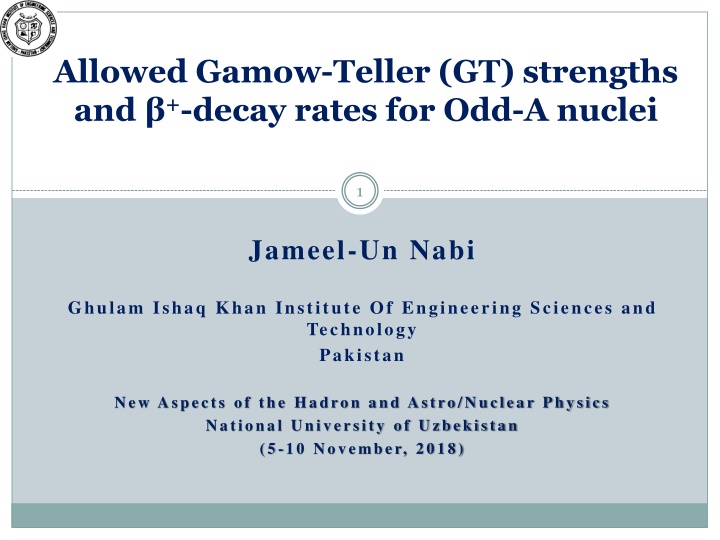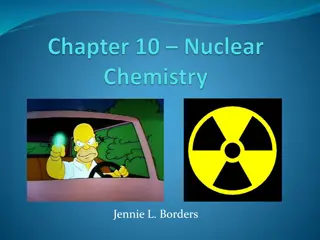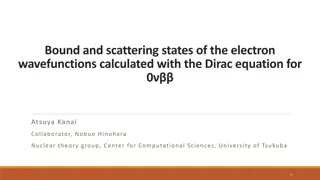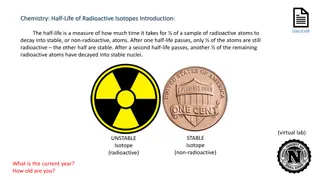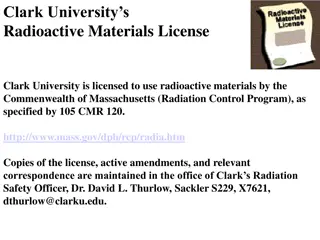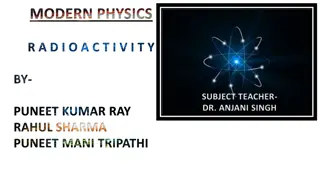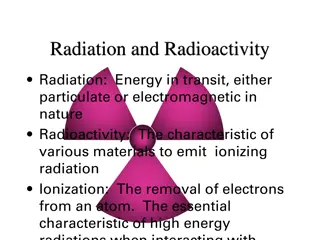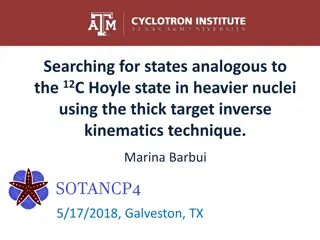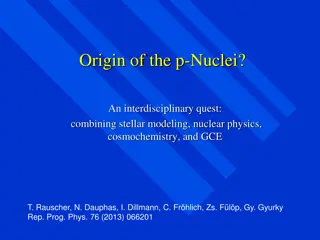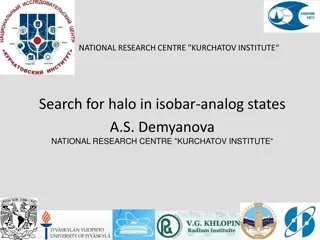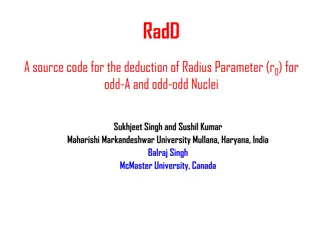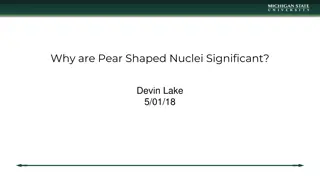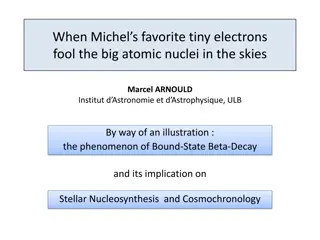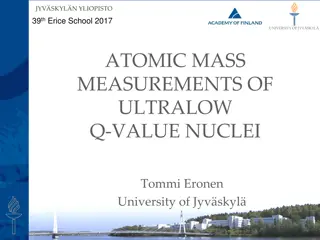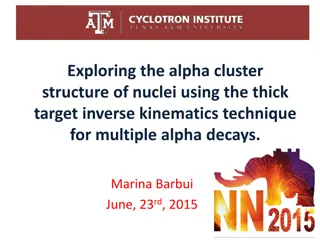New Aspects of GT Strengths and Decay Rates in Odd-A Nuclei
"Investigating the Gamow-Teller strengths and decay rates for Odd-A nuclei, this study explores the performance of QRPA calculations in nuclear models. Findings challenge prior assumptions and shed light on stellar evolution processes."
Download Presentation

Please find below an Image/Link to download the presentation.
The content on the website is provided AS IS for your information and personal use only. It may not be sold, licensed, or shared on other websites without obtaining consent from the author.If you encounter any issues during the download, it is possible that the publisher has removed the file from their server.
You are allowed to download the files provided on this website for personal or commercial use, subject to the condition that they are used lawfully. All files are the property of their respective owners.
The content on the website is provided AS IS for your information and personal use only. It may not be sold, licensed, or shared on other websites without obtaining consent from the author.
E N D
Presentation Transcript
Allowed Gamow-Teller (GT) strengths and +-decay rates for Odd-A nuclei 1 Jameel-Un Nabi Ghulam Ishaq Khan Institute Of Engineering Sciences and Technology Pakistan New Aspects of the Hadron and Astro/Nuclear Physics National University of Uzbekistan (5-10 November, 2018)
Collaboration 2 This work was done in collaboration with; Dr. Muhammad Majid And Mr. Muhammad Riaz Ghulam Ishaq Khan Institute Of Engineering Sciences and Technology Pakistan.
Outlines 3 Motivation of current work Stellar evolution Weak-decay processes Formalism used in the calculations of weak rates pn-QRPA model description Ikeda Sum Rule Comparison of calculated rates with measured data and previous calculations. Conclusions.
Motivation of Current Work 4 In a new study by Cole et al. [1], it was concluded that quasi- particle random phase approximation (QRPA) calculations show large deviations and overestimate the total experimental Gamow Teller (GT) strength for odd-A nuclei. It was also concluded that QRPA calculated electron capture rates exhibit larger deviation than those derived from the measured GT strength distributions. The main purpose of this study is to probe the findings of the Cole et al. work. This study gives useful information on the performance of QRPA-based nuclear models. Our findings show that this is not the case for all kind of QRPA calculations. [1] A. L. Cole et al., Phys. Rev. C 86 (2012) 015809.
The Life Cycle of a High Mass Star 5 Stars are born, live and die. They have a beginning, evolutionary phases and end. _______________________ http://astronomyonline.org/Stars/HighMassEvolution.asp 3/3/2025
Development of a Heavy Mass Star of (10-25) Solar Masses 6 Hydrostatic life of the star Main sequence star Red super giant star Advanced burning phases Gravitational collapse _____________________________ http://www.astronomy.ohio-state.edu/ pogge/Ast162/Unit2/structure.html 3/3/2025
Pre-Supernova Stage 7 ___________________________________________ http://abyss.uoregon.edu/ js/ast122/lectures/lec18.html 3/3/2025
Supernova 8 Electron degeneracy pressure support Stellar Core becomes so heavy Gravitational force increases If the Core mass is 1.4 Mo __________________________________________ http://www.nasa.gov/audience/forstudents/5-8/features/nasa-knows.html 3/3/2025
Evolutionary Stages of 25 M Star 9 Temperature Density StagesTime scale (T9) (g-cm-3) Hydrogen burning 7 x 106y 0.06 5 Helium burning5 x 105y Carbon burning600 y0.93 Neon burning1 y1.7 Oxygen burning6 months Silicon burning1 d4.1 Core collapseSeconds8.1 Core bouncemilliseconds _____________________________________________________ John W. Negele and E. Vogt, eds. Advances in nuclear physics. Vol. 27. Springer Science & Business Media, (2003). 0.23 7 x 102 2 x105 4 x 106 2.31 x 107 3 x 107 3 x 109 3 x 1014 34.8 3/3/2025
Weak Interaction Processes 10 The most general processes in nuclear decay in which weak interaction occur are given below: + + A Z A . X X e --decay: +-decay: Electron capture: Positron capture: + 1 Z A Z + + + A . X X e 1 Z + X + A Z A . X e 1 Z + + X + A Z A . X e + 1 Z 3/3/2025
Fermi and Gamow-Teller Transitions 11 Fermi Transitions: S=0 - n p e- Gamow-Teller Transitions: S=1 p - n e- 3/3/2025
Formalism used in our calculation 12 ( )ij ft The comparative half life of an ordinary decay from the state i of the parent nucleus to the state j of the daughter nucleus is related to the nuclear reduced transition probability as: B ij D = ( ) ft (1) B ij ij where 3 7 2 ln c 2 ..(2) = D 2 V 5 e 4 g m The value of D=6143 s is adopted in the calculations [2]. Nuclear reduced transition probability is given by: ( ) ij ij B B F = + ( ) 2 ( ) , ij g g B GT gA/gV = -1.2694 [3]. (3) A V [2] J. C. Hardy and I.S. Towner, Phys. Rev. C 79(5), (2009), 055502. [3] K. Nakamura, J. Phys. G, Nucl. Part. Phys., 37, (2010) 075021.
Continue.. 13 where 1 = 2 k ( ) B F | || || | , j t i (4) ij + 2 1 J k i 1 = (5) 2 k k ( ) | || || | , B GT j t i ij + 2 1 J k i k shows Pauli spin matrix and the term Ji represent the total spin of the level |i> , k t is known as the iso-spin raising and lowering operator . The capture (decay) rates of a transition from the ith state of a parent nucleus (Z, N) to the jth state of the daughter nucleus is given by = ( , ft , ) f T E ij f (6) ln 2 , ij ( ) ij
Nuclear Models 14 Electron captures rates and beta decays, are important in the modeling of astrophysical processes like hydrostatic burning phases, late presupernova stages of the stellar evolution, and synthesis of heavy elements above iron group nuclei in stellar furnaces. Different nuclear models are used to calculate the weak decay rates. The QRPA and Shell model are widely used for the large scale calculations of these weak rates in stellar environment.
Model Description (pn-QRPA) 15 The pn-QRPA model was first developed by Halbleib and Sorensen [4]. An extension of the model to deformed nuclei was given by Moller and Krumlinde [5]. In the present work in addition to the well known particle-hole (ph) force, the particle-particle (pp) interaction, first consider by Cha [6], is also taken into account by adding GT interaction to QRPA Hamiltonian. The Hamiltonian of the pn-QRPA model is given by, QRPA sp pair H H V = + Where is the single-particle Hamiltonian, is the pairing force, is the ph GT force, and is the pp GT force. + + ph pp , V V (A) GT GT sp H ph V pair V GT pp V GT Single-particle energies and wave functions were calculated in the Nilsson model, which takes into account nuclear deformation [7]. [4] J. A. Halbleib and R. A. Sorensen, Nucl. Phys. A, 98 (1967) 542. [5] J. Krumlinde and P. Moller, Nucl. Phys. A , 417 (1984) 419. [6] D. Cha, Phys. Rev. C 27 (1983) 2269. [7] S. G. Nilsson, Mat. Fys. Medd. Dan. Vid. Selsk, 29 (1955) No. 16.
Model Parameters 16 The pn-QRPA model requires a numbers of parameters The Nilsson Potential parameter taken from [8]. Pairing interaction strengths. The Gamow-Teller interaction strengths (for ph interaction) and (for pp interaction). The Nuclear Deformation parameter. 12 = = MeV p n A Q2 is electric quadruple moment taken from [9]. The Q-value of the reaction were taken from [10]. [8] S. G. Nilsson, Mat. Fys. Medd. Dan. Vid. Selsk 29 (1955) No. 16. [9] P. M oller et al., At. Data Nucl. Data Tables, 1 (2016) 109. [10] G. Audi, et al., Chinese Physics C 36, (2012)1157.
17 3/3/2025
Ikeda Sum Rule 18 Ikeda Sum Rule (Ikeda 1964) is a mathematical tool which connects the nucleon numbers (neutrons and protons) with the microscopic structure of a given nucleus through the total Gamow Teller strengths in either direction. It is formulated as: ISRre = B(GT-) - B(GT+) = 3fq 2 (N-Z). This rule is model independent. fq is the quenching factor. It provides a guideline for all theoretical calculations of GT strength function. Theoretical calculations of GT strength functions are supposed to fulfill the Ikeda sum rule. In our model the Hamiltonian (Eq. (A)) was tuned to reproduce the Ikeda sum rule. Nuclei B(GT-) B(GT+) ISRre (cal) ISRre (th) 45Sc 4.85 1.61 3.24 3.24 55Mn 8.40 3.00 5.40 5.40
GT transitions from 45Sc to 45Ca 19 (a) (n,p) data [W. P. Alford, et al., Nucl. Phys. A 531 97 (1991)] (b) pn-QRPA calculations (c) QRPA calculations using the Skyrme interactions [P. Sarriguren, Phys. Rev. C 87 045801 (2013)] (d) FRDM [P. Moller and J. Randrup, Nucl. Phys. A 514 1 (1990)] (e) Shell model [A. Poves et al., Nucl. Phys. A 694 157 (2001)] (f) Shell model [M. Honma et al., Phys. Rev. C 65 061301(R) (2004)].
Comparison of EC rates with FFN and LSSM for 45Sc 23 FFN [G. M. Fuller, W. A. Fowler and M. J. Newman, Ap. J. Suppl Ser 42 447 (1980); Ap. J. Suppl Ser 48 279 (1982); Ap. J. Suppl . Ser. 252 (1982) 715]. LSSM[K. Langanke and G. Martinez-Pinedo, At. Data Nucl. Data Tables 79 (2001) 1].
Calculated electron capture (EC) and positron emission (PE) rates for 45Sc 25
Conclusion 27 The pn-QRPA model fulfilled the Ikeda Sum Rule. For stellar applications the EC and PE rates over wide range of astrophysical density (10 1011 g/cm3) and temperature (0.01 GK to 30 GK) were calculated. We compared our calculated GT strength and EC rates both with the measured and previous calculations. Our results were in decent comparison with the measured data. We also compared our calculated EC rates with the FFN and LSSM results. The overall mutual comparisons show that at low temperatures the pn-QRPA computed EC rates are generally in agreement with LSSM. However at high temperature, the pn-QRPA calculated rates are enhanced than the FFN and LSSM rates. It was also concluded that at low temperature and high stellar density regions the PE rates may be neglected in simulation codes.
Thank you! Thank you ! 28
